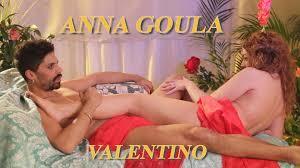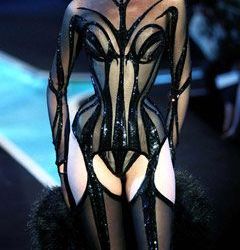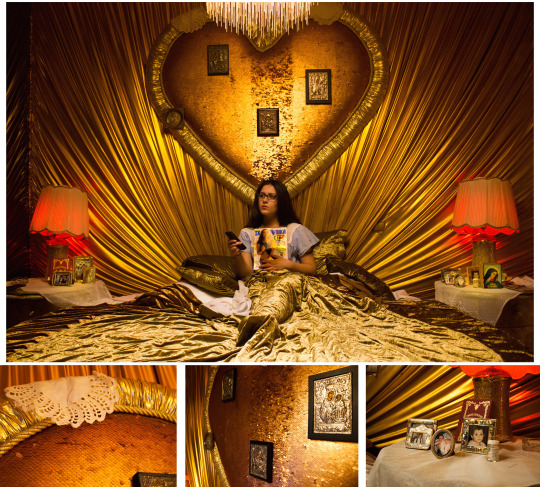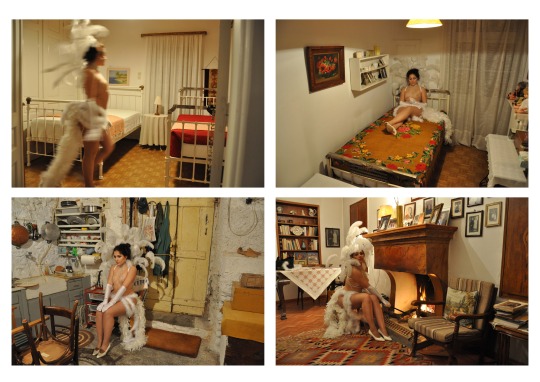#for my achievement last year of being published in the country’s most important photography magazine
Text
Vanity. Seems like a dated word and an old concept that has never been more prominent before today. What does vanity mean in a world of social media, cellphones and perpetual exposure? What does vanity mean in a world of lax morals and little dignity? What is dignity? What are morals? What are lax morals? Are they a bad thing? Who sets the bar? Everything is up for debate. Is it immoral to be so into yourself? Why is it frowned upon by some but glamourised by others? And if today’s world is characterised more and more by shameless vanity should we just all embrace it? Or should we be more critical of it? Is it an inherent thing that we learn to suppress due to societal standards or are we conditioned into it through societal pressure?
These are a few of my concerns and questions on the matter of vanity and to be honest I haven't been able to answer any. And to be even more honest every answer seems right. Depending on one’s point of view of course. In my case, my background and upbringing are a somewhat unorthodox mix of traditionality and forwardness that have made my confusion on the subject even more intense. My parents were raised in the rural town of Sparta, Greece. Greece, where I’m from, has always been a deeply traditional country that even though considered part of the western world, it has deeply rooted middle eastern influences that can be considered as more conservative. It has also been characterised throughout the years by a core dispute between communist and right wing parties and their respective followers which is still very prominent. Therefore the country itself is a nation defined by a series of conflicts and contradicting mentalities. However, the ‘westernisation’ that we espouse as a nation calls for an open-mindedness and progressiveness that Greeks were not eased into. And that has definitely created a sort of conflict for my peers and me. Because we are a generation that has grown up with the ideals and ethics of our parents and grandparents, family being a very strong institution in Greece, but with the need to keep up with current trends and norms and be more open to change. Moreover, carrying the weight of an ancient civilization that has shaped the entire humanity, we are expected to honour that heritage by adhering to expanding our intellectual capacities and disregarding superficiality. Therefore, it strikes me as odd and troubling when I see any greek girl my age posting pictures on instagram of her face accompanying it with a misspelled inspirational quote in english just to project a certain image of herself and simultaneously downplay the vanity angle by easing it with a ‘meaningful’ message. This is a common occurrence that is truly baffling to me which highlights the vast disparity between truth and image. This is also a recurring theme in many ancient greek written works such as the Odyssey; the concept of «είναι και φαίνεσθαι», the difference between reality and appearances.
On the other hand however, I wonder, am I just being an overly critical, contemptuous, angry person? I could cut people some slack. At the end of the day is vanity so bad? It has existed since the dawn of time and has been the driving factor behind many achievements I am sure. After all how can we distinguish vanity from self-love, ambition and confidence? They say be comfortable with your looks, love the skin you're in, but when does loving yourself become a little too much? These are questions that constantly trouble me and to which i have tried to give answers multiple times but to no avail.

Greek artist’s alter ego Anna Goula shown above is a trash pop singer who mocks contemporary Greek performers.
The most obvious and early tale of vanity is that of Narcissus. Enamoured by his own reflection but not being able to realise his feelings towards himself, he was burned by the flame of his own passion. This myth gave its name to what we now know as narcissism, the overt admiration of ones self and looks and their self-idealisation. Vanity, on the other hand, started off as a term referring to the futility and ephemeral nature of life and material things, however it has mostly become synonymous to narcissism and egomania in current times.
One very prominent example of how the social and cultural dynamics surrounding vanity have drastically changed over the past few years is the rise of the Kardashian aesthetic and the reign of instagram culture. Kim Kardashian has almost single-handedly rendered shameless vanity an acceptable if not desirable trait, and has even managed to capitalise on it by not only using it to expand her followers which in turn translate into more money but by also publishing a book full of her selfies, titled ‘selfish’ and rightfully so. I think that current instagram culture has a lot to give when it comes to insight on the matter and probably more so when it comes to ordinary people rather than celebrities.

Kim Kardashian’s aforementioned book.
I am also interested in how female artists like Cindy Sherman and Nan Goldin explore the female image and sexuality in their photography, which could provide insight coming from either a pro or anti vanity point of view. I also once attended a talk by Juno Calypso, a young photographer who explores the issue of vanity, self-worship, the futility of beauty and its attainability at any cost, through her site specific performances and photographs. Her pinky pastel aesthetic also alludes to stereotypical explicit femininity and seamlessly blends the past with the present. I would certainly like to look at artists like that whose strong aesthetics are a source of debate and inspiration.


Juno Calypso’s Honeymoon Series.
I would also like to look at Yorgos Lanthimos, the only famous Greek director who is currently the pride and joy of Greece due to his accolades. Even though I have only watched some of his movies in fragments, I was surprised by his distinct aesthetics and concepts when I saw a magazine editorial he shot with Taylor Hill. The young model is posing in her underwear in her grandmothers utterly traditional home, resulting in an unusual but very real and gritty visual, that speaks volumes to Lanthimos’ greekness. I would definitely want to explore his earlier movies more in depth, more so because of his exploration of greek social and familial dynamics rather than his exploration of vanity, but at the end of the day aren’t they both related?


Lanthimos’ shoot for V magazine.
Last but not least, I would like to look at how vanity is related to fetish and explore their relationship to fashion and cinema. Looking at collections and runways from the 90s by Thierry Mugler, the sheer theatricality of the models, the way they have been directed to essentially perform instead of simply carry out a catwalk and of course the clothes, inevitably bring to mind dominatrix-y aesthetics. Of course latex also plays an important role in forming that aesthetic and is a big part of the fetish notion which is worth looking into.


Thierry Mugler’s fashion shows.
I believe that all the works I have done so far have more or less included the element of vanity and body ideals in one way or another. Combining latex with traditional victorian hoop skirts was a way for me to explore the relationship between the traditional and the contemporary and examining the dynamics between the conservative and the sexual. I also tried to explore that relationship in my manifesto project, where I looked at my upbringing and more specifically my rural roots and the agricultural background of my family and tried to explore the gap between the aforementioned traits to the more ‘liberal’ and modern upbringing I had in the city. I also tried to explore that relationship in two linked performance/photography pieces I did last year, combining again my traditional background to my sexuality and self-admiration; one was set in my grandmother’s house while the other one was set in a temporary stay sex hotel in Athens. I feel like my experience so far with latex and pvc will prove useful, at least as material exploration and experimentation are concerned and will pave the way for me to explore further the notion of vanity and fetish through their material realisations.

My ‘Portrait of a millenial’ project, set in Priamos sex hotel in Athens. I placed objects like family photos, christian icons and doilies from my grandmother’s house and did traditionally ‘grandmother’ things like crossword puzzles as if I were in my own home.

Second part of my ‘Portrait of a millenial’ project. I made a revealing burlesque costume and wore it around my grandmother’s house to highlight the difference between the sexual and the flamboyant and the religious and traditional.
6 notes
·
View notes
Text
Thibault Roland
Fine Art Photographer/Biophysics Researcher
Boston, Massachusetts
thibaultroland.com
Photo by Satoru Murata
SPECIAL GUEST SERIES
Thibault Roland is a fine art photographer and biophysics researcher based in Boston, Massachusetts. He specializes in black and white seascapes, landscapes, and architecture, using long-exposure and tilt/shift techniques. A scientist by profession, Thibault earned a Ph.D. in physics and worked as a researcher at both Cornell University and Harvard University, where he studied fundamental biological mechanisms using optics and microscopy. Thibault’s work is represented by Kusch Gallery (Paris, France) and included in private and public collections. His work has also been recognized internationally by fine art organizations such as the International Photography Awards and the Prix de la Photographie de Paris. Thibault’s photography has appeared in international magazines and organizations, including Chasseur d'Images (France), Landscape Photography Magazine (UK), CameraPixo (US), Plus One Collection (book), Adore Noir Magazine (US), and The Municipal Art Society of New York. His public collections include the Boston Athenaeum's Prints & Photographs funds. Thibault is also an instructor at the New England School of Photography in Boston, and is supported by Sony via the Artisans of Imagery and the Global Imaging Ambassadors programs. When he’s not working, you can find him enjoying the company of friends, reading a good book, or in the darkroom testing alternate photography techniques. Thibault lives in the heart of Boston in a building from the late XIXth Century. His small apartment is filled with everything photography, ranging from the prints he collects to film and digital cameras and related equipment.

FAVORITES
Book: Game of Thrones by George R. R. Martin. I know, not very original, but for my defense I read it before it became popular.
Destination: Iceland, the Pacific Northwest, France
Film: Usual Suspects, Reservoir Dogs, Kill Bill
Motto: Sleep is overrated.
THE QUERY
Where were you born?
In Nancy, France.
What were some of the passions and pastimes of your earlier years?
When I was a teenager I used to play video games, and go to the movie theater and live music concerts with friends. I also was, and still am, an avid reader and travel lover. Every time I could discover a new place, either in my home town or in visiting another country, I would, and still do, jump on the occasion. I have always been fascinated by discovering new cultures, people, and places.
How did you begin to realize your intrigue with photography?
I started getting more and more attracted to photography, as I had the chance to travel abroad once or twice a year in my teens. Photography was a way for me to document these trips. About eight years ago, I started exploring the world of fine art photography and got more interested and curious about it as the years passed.
Why does this form of artistic expression suit you?
I have always been attracted to photography as a medium, more so than any other medium, such as painting or drawing. Being a scientist, I like the technical aspects of it, such as the way light can be shaped and directly imprinted onto a substrate. And, how the different printing, editing, and alternate photography techniques can actually blur out lines between these media, making photography sometimes look like an etching or a drawing. In a way, I find that photography gives me more versatility than other art forms. It has liberated me and offered many more options to express myself.
What path did your training/education follow?
I am a self-taught photographer. A few years ago I came across images taken by Micheal Kenna and fell in love with the unique look and atmosphere they had. I couldn't stop studying and admiring his work, and decided shortly thereafter to buy a neutral density filter. This is when I started the journey into long-exposure photography, and never stopped experimenting with it.
In what way has your scientific background played a role in your pursuit of/transition to photography?
My scientific background has played a really big role in my photographic adventures. I got more serious about photography about 10 years ago when I was writing my thesis. I needed an excuse to go outside, clear my mind, and forget about science before I got back to writing about it. I also did a lot of sports at the time, but photography was my way to release my creativity and share with others in a different way. Since then, my love for photography and focus have only deepened, and I started to incorporate scientific and technical elements into my work such as general relativity.
How did you get your start in the business of art?
My career as a photographer really started when I began showing some of my work in local galleries. I have always done photography because I loved it, and it turned out that other people liked my work too. I realized I could turn it into more than just a hobby, and little by little, I was able to publish in magazines in different countries, show in more prestigious galleries, and have some of my prints included in private and public collections. In the last year or so, I also started to organize workshops, and to do some commission work.
How would you describe your creative process?
My creative process always starts with scouting locations and constructing an image in my mind, even before I pull the camera out of my bag. I always try to transcend reality and create a world of my own by using my camera and lenses like a painter uses colors and brushes to make his vision come to life. In my opinion, vision, or as Ansel Adams used to call it "visualization," is the most important aspect that a photographer, or any kind of visual artist really has.
Then, it's a question of getting the right tools to achieve this vision. I will use these tools (cameras, lenses, editing techniques etc.) in a scientific and very controlled way, and yet let the situation and weather conditions impact and imprint on that vision to give the final image. In a way, I love to orient the final effect in a direction that I choose, and still leave enough to chance to be surprised in the end. In that regard, my creative process is very close to film photography: you never know what you will have until the image is shot and developed/edited. Many times it does not work, but sometimes you get the perfect result.
What techniques do you use to accomplish the effects of your photography?
I have been using long-exposure quite extensively these last few years. It is a technique that relies on very slow shutter speeds (minutes vs. hundredth of a seconds in normal photography), and allows for the movement of subjects to imprint on the image differently: clouds and cars will be seen as streaks, vegetation will blur out, waves in the ocean will disappear rendering the water flat, and people can simply vanish.
Another technique that I have used a lot recently is tilt/shift. This approach allows me to change the field of view and/or introduce blur in the image in a highly controlled way, directly in-camera. It is a powerful tool to compose an image, introduce mystery and mood and focus the viewer's attention on a particular subject.
Why do you shoot primarily in black and white?
As a lover of photography in general, I have always been attracted to the black and white masters from the old days such as Cartier-Bresson, Capa, Doisneau, Adams, and also to contemporary photographers such as Kenna and Sugimoto. It is not the only reason though. In my eyes, black and white photography forces the artist to see the world differently; to create a more compelling image by relying on shapes, lines, and textures. For me, black and white is not a restriction, as it is does not take away but actually gives more. More freedom in how I will construct my imagery because I will not necessarily be forced to keep color tonalities the same, and more versatility as I can turn day into night according to my inner vision. It also brings the viewer into a world that is intrinsically different from ours, as they step away from this reality. And, it creates a sense of wonder and mystery, and brings out their imagination.
What types of scenes do you typically focus on with your work?
I am mostly interested in seascapes, landscapes, and architecture.
What is it that draws you so strongly to these scenes?
I always look for subjects that will bring out an emotion to the viewer. A bright image will give a sense of calm and elation, while a very dark or contrasty one brings out tension and unease. For instance, seascapes have always captivated me. They are invitations to adventures, mysteries, and discoveries. A lighthouse is a perfect example, as they also bring out a sense of safety and strength. They are the beginning or the end of an odyssey. Landscapes and architectural photography tell stories about how man has shaped nature, making it mineral and strange. I love shooting such imagery, because taking out all human presence using long-exposure creates tension and mystery as we start feeling uncomfortable, expecting life where there is none in the image.
Do you have a favorite photograph and/or memory associated with a photograph you’ve shot?
My series Sticks has a lot of meaning to me. It shows pilings from broken-up piers which I shot mostly in California a few years ago. The first time I saw these pilings was after a job interview that I had in San Francisco. After the interview I had a few hours to kill before flying back to the North East, and thought I would scout the area. I did not have my camera equipment with me at the time but marked the location of these sticks. The interview process did not lead to a job offer, and it took me more than a year to go back and shoot a whole series of these pilings. When I look at these images now, I think back on the initial reason I was there, and how things could have been different, had I worked and lived there. In a way, this series is a symbol for me of modern life and how one's life and destiny is shaped by the sum of their decisions and experiences past.
What might we find in your camera collection?
All of the work on my website is digital, and I am currently shooting with a Sony a7RII camera. I also have a Sony a7R that I had converted for infra-red photography. That said, I do use a few medium format film cameras, and I love to shoot one of my older 4x5 or 8x10 cameras, mostly for alternate techniques such as wet plate.
What do you consider the most important themes in your work?
Time. It is present in all of my images, through the technique of long-exposure. I am fascinated with how time flows, how we relate to it, and how it impacts us and our environment.
Is there a period along the way that has presented an important learning curve?
I am currently learning alternate techniques; in particular collodion photography. This is definitely a challenge, very demanding, and every little detail counts. I love every step of it, especially when you see the image forming on your tin or glass plate. It can be tedious and frustrating at times but it's also very exciting and rewarding.
How has your style/approach evolved over the years?
In the past, I tended to do things much more organically, with much less intent and a more imprecise process. My imagery was also darker, with higher contrast and more moody. These days, I think of every little detail while creating my images, going from the way I compose them to how and why I would use this or that technique, lens, and editing process. My thought process is also much more elaborate. I work on my images as a whole body of work, and as a series. This is a very important part of my creative process now, one which was entirely absent in my initial approach.
Do you have an artistic resource that you turn to?
I use all kinds of resources, ranging from magazines to websites and newsletters: LensCulture, Photo District News, Sony Alpha Universe, and Lenscratch. But most of all, when I need advice or information, I love to turn to fellow photographers. In my experience, social media is a wonderful way to form bonds with fellow artists, and they are always happy to share about common passions.
What’s the best advice you’ve ever received?
Take criticism like it is: someone's opinion, good or bad. But don't take it too seriously. Do what you love, keep doing it, and keep showing your work.
From where do you draw inspiration?
I take my inspiration from all around me: myths and legends, science and history, science-fiction and movies, and TV or music.
Who in your life would you like to thank, and for what?
First and foremost, I would like to thank my mother, who has always believed in my artistic work and has always supported me in every one of my decisions and endeavors. I'd like to thank also the people and companies who have been supporting my work for many years, in particular Sony through their Artisans of Imagery and Global Ambassadors programs, and the many other photographers I have had so many deep and meaningful interactions with.
What three things can’t you live without?
My camera, a car (or any other means of transportation that allows me to discover new horizons), and a good book.
What drives you these days?
The thought that amazing places and people can be discovered either far away or right around the corner, and that I can share my adventures and feelings through my imagery.
0 notes